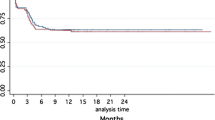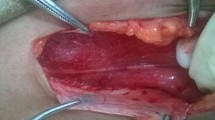Abstract
Purpose
We assessed the efficacy of iliohypogastric neurectomy and subcutaneous transposition of the spermatic cord and ilioinguinal and genital nerves on the incidence of postoperative chronic pain (PCP) after open inguinal hernia repair with polypropylene mesh.
Methods
Between October 2006 and November 2006, 54 adult male patients with primary inguinal hernia were randomised into two groups. In group A, we performed Lichtenstein hernia repair, neurectomy and the new procedure; in group B, only Lichtenstein’s operation was performed.
Results
One month after operation, the incidence rate of PCP was significantly lower in group A. At 6 months, there was no significant difference between both groups regarding PCP at rest and coughing. However, there were no patients who complained of PCP after walking and climbing up stairs in group A. The sensorial changes in the groin region were similar in the two groups.
Conclusion
This procedure decreases the incidence of physical activity-induced PCP, without increasing the risks of sensory changes.
Similar content being viewed by others
References
Bringman S, Ramel S, Heikkinen TJ, Englund T, Westman B, Anderberg B (2003) Tension-free inguinal hernia repair: TEP versus mesh-plug versus Lichtenstein: a prospective randomized controlled trial. Ann Surg 237:142–147
Kumar S, Wilson RG, Nixon SJ, Macintyre IM (2002) Chronic pain after laparoscopic and open mesh repair of groin hernia. Br J Surg 89:1476–1479
MRC Laparoscopic Groin Hernia Trial Group (1999) Laparoscopic versus open repair of groin hernia: a randomised comparison. Lancet 354:185–190
Fränneby U, Sandblom G, Nordin P, Nyrén O, Gunnarsson U (2006) Risk factors for long-term pain after hernia surgery. Ann Surg 244:212–219
Poobalan AS, Bruce J, Smith WC, King PM, Krukowski ZH, Chambers WA (2003) A review of chronic pain after inguinal herniorrhaphy. Clin J Pain 19:48–54
Bay-Nielsen M, Perkins FM, Kehlet H; Danish Hernia Database (2001) Pain and functional impairment 1 year after inguinal herniorrhaphy: a nationwide questionnaire study. Ann Surg 233:1–7
Mui WL, Ng CS, Fung TM, Cheung FK, Wong CM, Ma TH, Bn MY, Ng EK (2006) Prophylactic ilioinguinal neurectomy in open inguinal hernia repair: a double-blind randomized controlled trial. Ann Surg 244:27–33
Malekpour F, Mirhashemi SH, Ha**asrolah E, Salehi N, Khoshkar A, Kolahi AA (2008) Ilioinguinal nerve excision in open mesh repair of inguinal hernia—results of a randomized clinical trial: simple solution for a difficult problem? Am J Surg 195:735–740
Picchio M, Marcello P, Palimento D, Matarazzo PF, Bambini C, Caliendo A (2004) Randomized controlled trial of preservation or elective division of ilioinguinal nerve on open inguinal hernia repair with polypropylene mesh. Arch Surg 139:755–758
Wijsmuller AR, van Veen RN, Bosch JL, Lange JF, Kleinrensink GJ, Jeekel J, Lange JF (2007) Nerve management during open hernia repair. Br J Surg 94:17–22
Zieren J, Tsigris Ch, Menenakos Ch (2007) Open tension-free hernia repair in soccer players: preservation or primary neurectomy of the ilioinguinal nerve? Clin J Sport Med 17:398–400
Amid PK, Shulman AG, Lichtenstein IL (1996) Open “tension-free” repair of inguinal hernias: the Lichtenstein technique. Eur J Surg 162:447–453
Cunningham J, Temple WJ, Mitchell P, Nixon JA, Preshaw RM, Hagen NA (1996) Cooperative hernia study. Pain in the postrepair patient. Ann Surg 224:598–602
Amid PK (2004) Causes, prevention, and surgical treatment of postherniorrhaphy neuropathic inguinodynia: triple neurectomy with proximal end implantation. Hernia 8:343–349
Heise CP, Starling JR (1998) Mesh inguinodynia: a new clinical syndrome after inguinal herniorrhaphy? J Am Coll Surg 187:514–518
Loos MJ, Roumen RM, Scheltinga MR (2007) Classifying post-herniorrhaphy pain syndromes following elective inguinal hernia repair. World J Surg 31:1760–1765
Demirer S, Kepenekci I, Evirgen O, Birsen O, Tuzuner A, Karahuseyinoglu S, Ozban M, Kuterdem E (2006) The effect of polypropylene mesh on ilioinguinal nerve in open mesh repair of groin hernia. J Surg Res 131:175–181
EU Hernia Trialists Collaboration (2002) Repair of groin hernia with synthetic mesh: meta-analysis of randomized controlled trials. Ann Surg 235:322–332
Alfieri S, Rotondi F, Di Giorgio A, Fumagalli U, Salzano A, Di Miceli D, Ridolfini MP, Sgagari A, Doglietto G; Groin Pain Trial Group (2006). Influence of preservation versus division of ilioinguinal, iliohypogastric, and genital nerves during open mesh herniorrhaphy: prospective multicentric study of chronic pain. Ann Surg 243:553–558
O’Dwyer PJ, Kingsnorth AN, Molloy RG, Small PK, Lammers B, Horeyseck G (2005) Randomized clinical trial assessing impact of a lightweight or heavyweight mesh on chronic pain after inguinal hernia repair. Br J Surg 92:166–170
Post S, Weiss B, Willer M, Neufang T, Lorenz D (2004) Randomized clinical trial of lightweight composite mesh for Lichtenstein inguinal hernia repair. Br J Surg 91:44–48
Zieren J, Rosenberg T, Menenakos Ch (2008) Impact of ilio-inguinal nerve excision on sexual function in open inguinal hernia mesh repair: a prospective follow-up study. Acta Chir Belg 108:409–413
Pappalardo G, Frattaroli FM, Mongardini M, Salvi PF, Lombardi A, Conte AM, Arezzo MF (2007) Neurectomy to prevent persistent pain after inguinal herniorraphy: a prospective study using objective criteria to assess pain. World J Surg 31:1081–1086
Author information
Authors and Affiliations
Corresponding author
Rights and permissions
About this article
Cite this article
Caliskan, K., Nursal, T.Z., Caliskan, E. et al. A method for the reduction of chronic pain after tension-free repair of inguinal hernia: iliohypogastric neurectomy and subcutaneous transposition of the spermatic cord. Hernia 14, 51–55 (2010). https://doi.org/10.1007/s10029-009-0571-5
Received:
Accepted:
Published:
Issue Date:
DOI: https://doi.org/10.1007/s10029-009-0571-5




